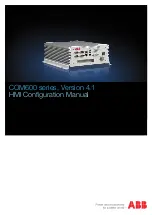
30
P
ING
C
OMMANDS
Overview
Ping (Packet Internet Gopher) is a program used to test reachability of destinations
by sending them an ICMP echo request and waiting for a reply.
Ping Command
ping
<destination IP_name
or address>
The
ping
command sends a ping (ICMP echo request) to a remote IP host. This
tool to test connectivity can also be initiated from an SNMP station. The CLI can
perform a ping with either verbose or background selected, but not both.
Verbose
causes the CLI to display information for each PING transmitted.
Background
causes the CLI to start the PING request and returns you to the prompt until results
are ready.
You can configure the following parameters for the
ping
command:
background
[yes | no]
count
<maximum packets>
data
<string>
interval
<seconds>
self_destroy_delay
<minutes>
size
<data size>
timeout
<period>
verbose
[yes | no]
Parameters
Description
<IP_name or
address>
IP address in dotted notation, or host name of remote system.
background
When selected, pings are run in a background process on your screen. Can
choose either background or verbose, not both. The default is
NO
.
count
Number of pings requests to send. The default is
1
. The range is
1-1000
.
data
String value specifying data to be sent.
Note: If data length is bigger than ping size, only the first ping size octets are
used. If data length is zero, the server uses random data. If data length is
smaller than ping size, the data pattern will be repeated as many times as
necessary to fill up the transmission buffer.
The range is
0-255 ASCII characters
.
interval
Period in seconds between successive ping requests. Note that the actual
interval might be different for any given transmission, because the server will
not send a new request before a previous request is completed (replied to or
timed-out). The default is
1 second
. The range is
1-65535.
Summary of Contents for OfficeConnect 3C100XF
Page 1: ...http www 3com com OfficeConnect Gateway CLI User s Guide Release 1 0 Part No 10042302 Rev AA ...
Page 14: ...xiv ...
Page 18: ...iv ABOUT THIS GUIDE ...
Page 30: ...1 12 CHAPTER 1 USING THE COMMAND LINE INTERFACE CLI ...
Page 50: ...3 14 CHAPTER 3 ADMINISTRATIVE CLI COMMANDS ...
Page 58: ...4 8 CHAPTER 4 CONFIGURING AND MANAGING USERS ...
Page 70: ...6 8 CHAPTER 6 BRIDGING COMMANDS ...
Page 78: ...8 4 CHAPTER 8 INTERFACE COMMANDS ...
Page 82: ...9 4 CHAPTER 9 ARP COMMANDS ...
Page 88: ...11 4 CHAPTER 11 DHCP COMMANDS ...
Page 124: ...12 36 CHAPTER 12 IP ROUTING COMMANDS ...
Page 134: ...13 10 CHAPTER 13 DNS COMMANDS ...
Page 142: ...15 6 CHAPTER 15 MULTICASTING AND IGMP COMMANDS ...
Page 160: ...17 8 CHAPTER 17 PPP COMMANDS ...
Page 182: ...21 6 CHAPTER 21 ADDRESS TRANSLATION COMMANDS ...
Page 186: ...22 4 CHAPTER 22 IPSEC COMMANDS ...
Page 188: ...23 2 CHAPTER 23 SECURITY ASSOCIATION SA COMMANDS ...
Page 192: ...24 4 CHAPTER 24 TCP COMMANDS ...
Page 204: ...25 12 CHAPTER 25 SNMP COMMANDS ...
Page 210: ...26 6 CHAPTER 26 IP FILTERS COMMANDS ...
Page 238: ...29 6 CHAPTER 29 TRACEROUTE COMMANDS ...
Page 255: ...xv RFC 1483 16 3 RFC 1483 MER 16 4 ...
Page 256: ...xvi ...
Page 260: ......
















































